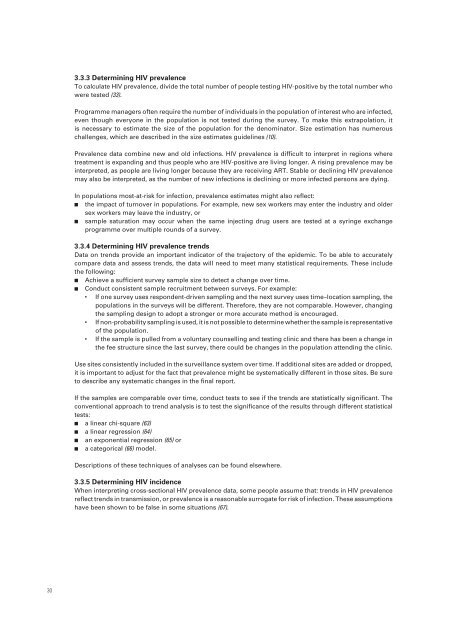Guidelines on surveillance among populations most at risk for HIV
Guidelines on surveillance among populations most at risk for HIV
Guidelines on surveillance among populations most at risk for HIV
- No tags were found...
Create successful ePaper yourself
Turn your PDF publications into a flip-book with our unique Google optimized e-Paper software.
3.3.3 Determining <strong>HIV</strong> prevalenceTo calcul<strong>at</strong>e <strong>HIV</strong> prevalence, divide the total number of people testing <strong>HIV</strong>-positive by the total number whowere tested (33).Programme managers often require the number of individuals in the popul<strong>at</strong>i<strong>on</strong> of interest who are infected,even though every<strong>on</strong>e in the popul<strong>at</strong>i<strong>on</strong> is not tested during the survey. To make this extrapol<strong>at</strong>i<strong>on</strong>, itis necessary to estim<strong>at</strong>e the size of the popul<strong>at</strong>i<strong>on</strong> <strong>for</strong> the denomin<strong>at</strong>or. Size estim<strong>at</strong>i<strong>on</strong> has numerouschallenges, which are described in the size estim<strong>at</strong>es guidelines (10).Prevalence d<strong>at</strong>a combine new and old infecti<strong>on</strong>s. <strong>HIV</strong> prevalence is difficult to interpret in regi<strong>on</strong>s wheretre<strong>at</strong>ment is expanding and thus people who are <strong>HIV</strong>-positive are living l<strong>on</strong>ger. A rising prevalence may beinterpreted, as people are living l<strong>on</strong>ger because they are receiving ART. Stable or declining <strong>HIV</strong> prevalencemay also be interpreted, as the number of new infecti<strong>on</strong>s is declining or more infected pers<strong>on</strong>s are dying.In popul<strong>at</strong>i<strong>on</strong>s <strong>most</strong>-<strong>at</strong>-<strong>risk</strong> <strong>for</strong> infecti<strong>on</strong>, prevalence estim<strong>at</strong>es might also reflect: the impact of turnover in popul<strong>at</strong>i<strong>on</strong>s. For example, new sex workers may enter the industry and oldersex workers may leave the industry, or sample s<strong>at</strong>ur<strong>at</strong>i<strong>on</strong> may occur when the same injecting drug users are tested <strong>at</strong> a syringe exchangeprogramme over multiple rounds of a survey.3.3.4 Determining <strong>HIV</strong> prevalence trendsD<strong>at</strong>a <strong>on</strong> trends provide an important indic<strong>at</strong>or of the trajectory of the epidemic. To be able to accur<strong>at</strong>elycompare d<strong>at</strong>a and assess trends, the d<strong>at</strong>a will need to meet many st<strong>at</strong>istical requirements. These includethe following: Achieve a sufficient survey sample size to detect a change over time. C<strong>on</strong>duct c<strong>on</strong>sistent sample recruitment between surveys. For example:• If <strong>on</strong>e survey uses resp<strong>on</strong>dent-driven sampling and the next survey uses time–loc<strong>at</strong>i<strong>on</strong> sampling, thepopul<strong>at</strong>i<strong>on</strong>s in the surveys will be different. There<strong>for</strong>e, they are not comparable. However, changingthe sampling design to adopt a str<strong>on</strong>ger or more accur<strong>at</strong>e method is encouraged.• If n<strong>on</strong>-probability sampling is used, it is not possible to determine whether the sample is represent<strong>at</strong>iveof the popul<strong>at</strong>i<strong>on</strong>.• If the sample is pulled from a voluntary counselling and testing clinic and there has been a change inthe fee structure since the last survey, there could be changes in the popul<strong>at</strong>i<strong>on</strong> <strong>at</strong>tending the clinic.Use sites c<strong>on</strong>sistently included in the <strong>surveillance</strong> system over time. If additi<strong>on</strong>al sites are added or dropped,it is important to adjust <strong>for</strong> the fact th<strong>at</strong> prevalence might be system<strong>at</strong>ically different in those sites. Be sureto describe any system<strong>at</strong>ic changes in the final report.If the samples are comparable over time, c<strong>on</strong>duct tests to see if the trends are st<strong>at</strong>istically significant. Thec<strong>on</strong>venti<strong>on</strong>al approach to trend analysis is to test the significance of the results through different st<strong>at</strong>isticaltests: a linear chi-square (63) a linear regressi<strong>on</strong> (64) an exp<strong>on</strong>ential regressi<strong>on</strong> (65) or a c<strong>at</strong>egorical (66) model.Descripti<strong>on</strong>s of these techniques of analyses can be found elsewhere.3.3.5 Determining <strong>HIV</strong> incidenceWhen interpreting cross-secti<strong>on</strong>al <strong>HIV</strong> prevalence d<strong>at</strong>a, some people assume th<strong>at</strong>: trends in <strong>HIV</strong> prevalencereflect trends in transmissi<strong>on</strong>, or prevalence is a reas<strong>on</strong>able surrog<strong>at</strong>e <strong>for</strong> <strong>risk</strong> of infecti<strong>on</strong>. These assumpti<strong>on</strong>shave been shown to be false in some situ<strong>at</strong>i<strong>on</strong>s (67).30















